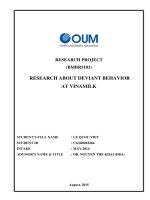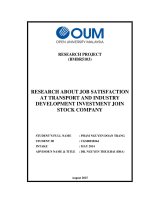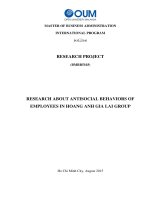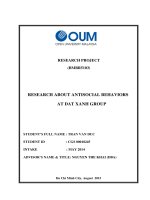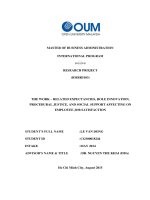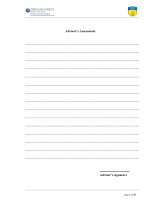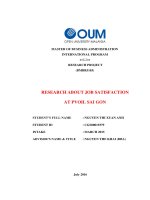Research about antisocial behaviors at dat xanh group
Bạn đang xem bản rút gọn của tài liệu. Xem và tải ngay bản đầy đủ của tài liệu tại đây (1.12 MB, 76 trang )
RESEARCH PROJECT
(BMBR5103)
RESEARCH ABOUT ANTISOCIAL BEHAVIORS
AT DAT XANH GROUP
STUDENT’S FULL NAME : TRAN VAN DUC
STUDENT ID
: CGS 00018245
INTAKE
: MAY 2014
ADVISOR’S NAME & TITLE: NGUYEN THE KHAI (DBA)
Ho Chi Minh City, August 2015
ADVISOR’S ASSESSMENT
……………………………………………………………………………………………………………………………………………………..
……………………………………………………………………………………………………………………………………………………..
……………………………………………………………………………………………………………………………………………………..
……………………………………………………………………………………………………………………………………………………..
……………………………………………………………………………………………………………………………………………………..
……………………………………………………………………………………………………………………………………………………..
……………………………………………………………………………………………………………………………………………………..
……………………………………………………………………………………………………………………………………………………..
……………………………………………………………………………………………………………………………………………………..
……………………………………………………………………………………………………………………………………………………..
……………………………………………………………………………………………………………………………………………………..
……………………………………………………………………………………………………………………………………………………..
……………………………………………………………………………………………………………………………………………………..
……………………………………………………………………………………………………………………………………………………..
……………………………………………………………………………………………………………………………………………………..
Advisor’s signature
NGUYEN THE KHAI (DBA)
Business Research Methods
ACKNOWLEDGMENTS
This thesis cannot be completed without the encouragement and guidance
and support of many individuals and organizations. First, I would like to sincerely
thank the lecturers of Hutech University, especially the Master program OUM, has
dedicated teaching guide I completed modules in the program MBA. Through that
helped me get those reviews knowledge, experience required to perform this thesis.
I would like to express respect and gratitude to Dr. Nguyen The Khai, my
guide lecturer. During the past years, I have dedicated guidance, instructions, guide
me perform thesis. These reviews, reviews of teacher, especially the suggestions
toward solving problems throughout the research process, is really invaluable lesson
for me not only for the implementation of this thesis but also in work and life his
present. I would like to express sincere thanks to leadership and my peers has
always encouraging and enabling me to complete the thesis. Finally, I would like to
send hearts to my family. Through the last time, family is always encouragement
and inspirational for me to complete the thesis.
Once again, I thank very much to all
Tran Van Duc Student
Student: Tran Van Duc (CGS 00018245)
Page 1
Business Research Methods
CONTENTS
ACKNOWLEDGMENTS .......................................................................................................... 1
ABSTRACT................................................................................................................................ 7
CHAPTER I: INTRODUCTION................................................................................................ 8
I. INTRODUCTION OF DXG' GROUP .................................................................................. 8
1.1. Over view of the company ................................................................................................... 8
1.2. Products and brand name ...................................................................................................11
1.3. Business Objectives ...........................................................................................................12
1.4. HR policies of DXG: .........................................................................................................13
1.5. Organizational Structure ....................................................................................................15
II. RESEARCH INTRODUCTION ..........................................................................................15
2.1 Problem statement...............................................................................................................15
2.2 Main construct ....................................................................................................................17
2.3 Research objectives.............................................................................................................18
2.4. Research questions .............................................................................................................18
2.5. Research scope ...................................................................................................................18
2.6. Significance of research .....................................................................................................19
2.7. Limitation of research ........................................................................................................19
CHARPTER II: LITERATURE REVIEW...............................................................................20
I. THE ESSENCEOF BEHAVIOR AGGRESSION ................................................................20
1.1 Around the concept of aggression ......................................................................................20
1.2 The aggressive behavior: ....................................................................................................20
1.3 Classification of behavior of aggression: ............................................................................21
II. THE APPROACHES VIEWS OF AGGRESION: ..............................................................22
2.1 Theory instinct of aggression:...........................................................................................23
Student: Tran Van Duc (CGS 00018245)
Page 2
Business Research Methods
2.2 Theories drive of aggression: ............................................................................................23
2.3 Theory behavior of aggression: ..........................................................................................24
2.4 Social learning Theory on aggression: ................................................................................24
III. A FEW OF FACTORS CAUSING ANTISOCIAL BEHAVIOR COMPANY.................24
3.1 Working tension ..................................................................................................................24
3.2 Work-family conflict ..........................................................................................................24
3.3 Job Stress: ...........................................................................................................................25
3.4 Job overload: .......................................................................................................................25
IV THE STUDIES RELATED ANTISOCIAL BEHAVIORS ................................................27
4.1 Feelings of anger related to confront acts .........................................................................27
4.2 Frustration leads to aggression ...........................................................................................28
4.3 Repressed anger will ruin the body.....................................................................................30
4.4 Guns and aggressive behavior ............................................................................................31
4.5 Reduce aggressive behavior................................................................................................32
CHARPTER III: RESEARCH MODEL AND HYPOTHESES ..............................................34
I. RESEARCH MODEL ............................................................................................................34
1.1 Dependent Variables: ........................................................................................................34
1.2 Independent Variables: .......................................................................................................34
1.3 Constructs ...........................................................................................................................35
II. RESEARCH HYPOTHESES ..............................................................................................35
2.1. Work tension ......................................................................................................................35
2.2. Job overload .......................................................................................................................36
2.3. Job stress ............................................................................................................................36
2.4. Work-family conflict .........................................................................................................37
III. RESEARCH DESIGN ........................................................................................................37
Student: Tran Van Duc (CGS 00018245)
Page 3
Business Research Methods
3.1 Work tension .......................................................................................................................37
3.2 Job overload .........................................................................................................................39
3.3 Job stress ..............................................................................................................................40
3.4 Work-Family conflict .........................................................................................................43
3.5 Antisocial behaviour ...........................................................................................................44
IV. DATA COLLECTION PROGRESS ..................................................................................45
CHARPTER IV: ANALYSIS AND RESULT .........................................................................47
I. CRONBACH’S ALPHA .......................................................................................................47
1.1 Cronbach’s Alpha standard applied ....................................................................................47
1.2 Cronbach’s Alpha of constructs ..........................................................................................47
II. DESCRIPTIVE STATISTICS .............................................................................................49
III. REGRESION INFORMATION .........................................................................................50
IV. HYPOTHESIS TESTING ..................................................................................................51
4.1 Hypothesis proposed (H1) ..................................................................................................51
4.2 Hypothesis proposed (H2) ..................................................................................................52
4.3 Hypothesis proposed (H3) ..................................................................................................53
4.4 Hypothesis proposed (H4) ................................................................................................55
CHARPTER V: DISCUSSION AND CONCLUSIONS .........................................................57
I. DISCUSSION AND CONCLUSIONS .................................................................................57
II. LIMITATION OF RESEARCH ..........................................................................................58
REFERENCE............................................................................................................................59
APPENDIX 1 ............................................................................................................................63
Appendix 2: Presentation ..........................................................................................................71
Student: Tran Van Duc (CGS 00018245)
Page 4
Business Research Methods
TABLE
Table 1: Work Tension .............................................................................................................39
Table 2: Job Overload ...............................................................................................................40
Table 3: Job Stress ....................................................................................................................43
Table 4:Work-Family Conflict .................................................................................................44
Table 5: Antisocial Behavior ....................................................................................................45
Table 6: Time table for data collection progress ......................................................................46
Table 7: Cronbach’s Alpha - Internal Consistency ...................................................................47
Table 8 : Case Processing Summary.........................................................................................48
Table 9: Reliability Statistics ....................................................................................................48
Table 10: Cronbach’s Alpha of all Variables ...........................................................................48
Table 11: Item-Total Statistics ..................................................................................................49
Table 12: Descriptive Statistics ................................................................................................50
Table 13: Variables Entered/Removed ....................................................................................50
Table 14: Model summary ........................................................................................................50
Table 15: Coefficients ...............................................................................................................51
Table16: Model summary of H1 ...............................................................................................52
Table 17: Coefficients of H1 ....................................................................................................52
Table 18: Model summary of H2 ..............................................................................................53
Table19: Coefficients of H2 .....................................................................................................53
Table 20: Model summary of H3 ..............................................................................................54
Table 21: Coefficients of H3 ...................................................................................................54
Table 22: Model summary of H4 ..............................................................................................55
Table 23: Coefficients of H4 ....................................................................................................55
Table 24: Hypothesis result ......................................................................................................56
Student: Tran Van Duc (CGS 00018245)
Page 5
Business Research Methods
FIGURE & LIST OF ABBREVIATIONS
Figure1: Organizational Structure of DXG......................................................................... 15
Figure 2: Research model ..................................................................................................... 34
LIST OF ABBREVIATIONS
CEO
Chief Executive Officer
DXG
Dat Xanh group
HCM
Ho Chi Minh city
VND
Viet Nam currency
JB
Job overload
WT
Work tension
JS
Job stress
AB
Antisocial behavior
WK
Work-family conflict
SPSS
Statistical Package for Social Science
WTO
World Trade Organization
TPP
Trans-Pacific Strategic Economic Partnership Agreement
Student: Tran Van Duc (CGS 00018245)
Page 6
Business Research Methods
ABSTRACT
This purpose of this research is way to find the factors influence to the antisocial
behaviors in the work of the employees working at DXG.
This research was conducted by quantitative method with source data is surveys
that it issued by offline to 390 employees of DXG to collect the ideas and comments of
employees about antisocial behaviors. Next, the result of these surveys shall be statistically
analyzed by SPSS – Statistical analysis software. Hypotheses used this research includes
five constructs: one dependent variable (Antisocial Behavior) and four independent
variable (work tension, job overload, work-family behavior, job stress).
I hope the study results will be a source of reference for all levels of DXG leader in
developing business policies and HR. Building business policy and good working
environment employees will mitigate the impact aggressive action for the company and
increase work efficiency, the competitiveness of companies in the real estate market in
Vietnam.
Key words in this research: Antisocial Behavior, work tension, job overload, workfamily behavior, job stress and DXG.
Student: Tran Van Duc (CGS 00018245)
Page 7
Business Research Methods
CHAPTER I: INTRODUCTION
I am pleased to introduce a study on "Antisocial Behavior: Factors affecting
the antisocial behaviors in the work of the employees at Dat Xanh Group (Group
DXG) ".
I. INTRODUCTION OF DXG' GROUP
1.1. Over view of the company
DXG was established in 2003 with initial charter capital of 0.8 billion VND
and 10 employees. This time, DXG specializes in brokerage activities for real estate
projects.
With strategic vision, acumen, DXG has created a sales process completely
new, innovative marketing methods, breakthroughs. The DXG distribution projects
are large resonate. The focus of the sales companies are attracting hundreds of
customers to participate, creating a powerful effect on the market. DXG gradually
dominate and take over the role of marketing and distribution of real estate projects
has been the strength of foreign companies.
DXG is one of the pioneers in the problem of information transparency of
real estate products. The entire process of project implementation, sales processes,
are closely monitored. Human resources with knowledge and enthusiasm
continually improving expertise in special training courses. DXG is hundreds
counselor Real Estate Professionals always serve our customers and offering
thoughtful advice for effective investment. The title "Prize gold sales and the real
estate trading floors of the Year 2009" by the Association of Real Estate Vietnam
authentication attests to the efforts of DXG.
Model, business methods of scientific, creative, respected reputation, product
quality, meet customer needs and the market, social DXG has been recognized as a
business unit estate the leading prestige.
Student: Tran Van Duc (CGS 00018245)
Page 8
Business Research Methods
Sales of the company continued to grow at a high rate, averaging over 200%
/ year continuous growth and stable even during the financial crisis in 2007 so far.
2009 and 2010, DXG has contributed to revitalizing the real estate market
area of Dong Nai, Binh Duong, Ho Chi Minh City with a series of projects that
DXG as an investor and investment cooperation was announced as : Phuoc Hung,
Hoang Gia, Green Valley, Giang Dien, Dai Phuoc Lotus, Phu Gia Hung, Sunview
Apartment, The Morning Star Plaza ... Profit before tax of hundreds of billion, up
almost 6 times more than in 2008.
Currently, the company DXG Real Estate has a strong distribution system in
Vietnam. DXG distribution system constantly spread throughout the provinces with
nearly 20 branches, subsidiaries, associated companies, joint ventures, operating in
all areas of real estate transactions vibrant.
Customer database of companies is increasing. Currently, the company has a
database of over 1,000.000 potential clients and more than 100,000 patrons. With its
strong distribution system and rich data source, DXG has supported partners to
reach customers most effectively.
With solid experience in distribution, management and development of real
estate projects, professional staff - talent with the potential increase in finance ...
DXG officially expanded into the field Investment projects in 2007. A series of
large-scale project has an area of hundreds of hectares with investment of up to
thousands of billion due DXG ownership and investment cooperation such as Suoi
Son urban area, area Urban Services - Tourism - Eco Giang Dien Urban Area Green
Valley, The Morning Star Plaza, Phu Gia Hung Apartment, Apartment Sunview ...
customers warmly received by the prestige and quality of products Is. In addition to
the projects already completed, DXG currently being implemented nearly 20
projects in strategic locations, in the big cities and the potential provinces and cities
nationwide as: Arisen, TNT, Minh Hung, Tien Phuoc, Thu Duc, District 9 (HCM),
Student: Tran Van Duc (CGS 00018245)
Page 9
Business Research Methods
Pacific Riverside, Hung Phuoc and Phuoc, Royal ... (Binh Duong), Park Apartments
- luxury villa DXG (Vung Tau), the project urban area in Nhon Trach and Long
Thanh Bien Hoa, Trang Bom (Dong Nai), residential investment complex of Chan
May - Lang Co in Thua Thien Hue .... Looking ahead, DXG continues to expand
geographical areas, investment forms, links with partners, providing real estate
products to meet the diverse needs time to settle and investment needs of customers.
Investment activity will be the key business strategies of DXG in the near future.
The link, expand cooperative relationships with financial institutions, banks
... as well as an element to be placed on top of the business strategy of the Group
DXG. Through this orientation, Green Earth'd venture, association ... with all these
partners have the same development strategy based on sustainable cooperation.
DXG is now a strategic partner of major financial institutions such as FPT Capital,
TPBank ...
On 22/12/2009 stock DXG with code officially listed on Ho Chi Minh Stock
Exchange brought the company into a public company DXG. This is an important
milestone in the development strategy DXG become a strong group in the market
Real Estate Vietnam and beyond the world.
Over 10 years of development, so far total business capital of DXG reached
1,000 billion with over 1,500 employees and 20 subsidiaries and associates.
expected by 2017 DXG will become conglomerate, took Property sector as central
axis lifting totaling 3.500 billion and 2,500 employees. Currently, DXG ongoing
partnerships expand the international distribution channel expansion into Southeast
Asia to seize new business opportunities in the trend of globalization.
To respond promptly demanding environment of international business, and
strategy to expand the scope of activities, ongoing DXG deploy a comprehensive
program of human resource development, infrastructure finance ... All activities of
the company have been computerized using modern software including business
Student: Tran Van Duc (CGS 00018245)
Page 10
Business Research Methods
software and manage online real estate, ERP software enables optimized
management enterprise business process management system in accordance with
international standards ... With modern software, specifically, the operator can
control the operation of the whole system, make decisions quickly, The most
accurate, customers can trade DXG products immediately while at home, at work,
in cafes ... or anywhere worldwide.
In an effort overall, DXG is implementing its commitment to customers and
partners - to the DXG customers, our partners will surely get satisfaction. Do not
stop at the success, DXG continues to move forward and promote the value of the
whole system offers Vietnam to accomplish goals and conquer new heights. Head
office of the company is located at:
27 Dinh Bo Linh street, ward24, Binh Thanh District, HCM city.
Phone: 08. 6252 5252
Fax: 08. 6285 3896
Email:
Website: www.datxanh.com.vn
Logo:
1.2. Products and brand name
DXG activity areas of abundant: from trading in real estate, investment and
development of real estate projects, commercial centers, offices for rent, hotels,
restaurants, distribution and marketing projects Investment Real Estate to finance,
securities brokerage ...
The company has developed 16 real estate projects with thousands of
apartments and townhouses sold.
Student: Tran Van Duc (CGS 00018245)
Page 11
Business Research Methods
DXG products very diverse group suitable for all investors from low income
to high. Timely capture the government's policy on housing, the company has
focused on developing strong housing segment for lower income people and are
supported 30.000 billion loan package.
DXG product group customers appreciate such projects Sunview, Phu Gia
Hung Apartment, The Morning Star, 4S Riverside Linh Dong ...
1.3. Business Objectives
Vision
Becoming a multi-industry group, the majority owner, the leading
multinational in Vietnam and the region.
Mission
DXG works to provide quality products and best commercial services, create
added value for customers, benefits for investors and shareholders. Constantly
improve the standard of living for employees to deliver value for shareholders
benefit, contribute positively to the community, contributing to the socio-economic
development of the country.
Core values
DXG is a provider of real estate solutions prestige with quality products, bring
the maximum peace of mind for customers and partners.
Business Philosophy
Always understanding, build confidence and preserve credibility with
customers, partners and shareholders
Constant innovation to best meet the needs of customers
Student: Tran Van Duc (CGS 00018245)
Page 12
Business Research Methods
Transparent information timely, share success with customers, partners and
shareholders
1.4. HR policies of DXG:
Training and development
Training and development is the motto of Dat Xanh to create talents and
skillful managers.
On the first days at Dat Xanh, you will attend a training course in integration
conducted by the leaders of the Group.
Besides, the Group also have advanced courses in professional skills
periodically run in Vietnam and overseas in order to improve the expertise of the
staff and train subsequent managers.
Young - Dynamic Working Environment
We constantly improve the working environment, working conditions, to
bring as much comfort as possible to Dat Xanh staff.
When you come to Dat Xanh, you will be surprised at a young, dynamic,
enthusiastic, confident and sociable and friendly staff.
Raise and bonus
Raise: Salary increase will be considered every 6 months. The level of
increase depends on the employee’s performance over the last 6 months.
Bonus: 13th month bonus is always highest compared to other real estate
companies; employees also receive monthly and irregular bonuses for good
performance. There are also bonuses on public holidays: New Year's Day,
Independence Day, September 2, etc.
Welfare beyond salary:
Student: Tran Van Duc (CGS 00018245)
Page 13
Business Research Methods
In addition to income from wages, employees also receive the following
benefits, incentives and gifts:
Gifts on Lunar New Year's; Mid-Autumn Festival; Gifts for female staff on
March 8 and October 10; gifts for employees’ children on June 1, (1 to 15 years old
regardless of number of children).
In addition, employees also receive allowance for lunch, parking and,
depending on an employee’s rank, additional allowance for phonecard, cellphone,
business trip, traveling.
In order to stabilize employees’ life, work and their long-term commitment
to the Group. Welfare policy is meant to ensure worthy and harmonious benefits
according to the empoyees’ contribution to the Group.
Housing support: Prices for houses of the Group can be reduced by 15%
compared to market prices. Employees need to pay only 50% of the value of the
house in advance under construction progress, the remaining 50% may be paid by
installments within 5 years from the day on which the house is received without any
interest.
Giving houses: For employees who have many achievements and long-term
commitment to the Group.
Bonus shares to employees: For employees have many achievements and
long-term commitment to the Group.
Free sports services are weekly provided for employees. Sports competitions
are usually held in order for the staff to play and improve their health.
Tourism: Domestic and overseas tours: 1-2 times / year, depending on
the time of the Group's business.
Share with social responsibility: Kindness to everyone in the
community and noble from the virtue of a human being, thus employees are
Student: Tran Van Duc (CGS 00018245)
Page 14
Business Research Methods
encouraged to become a participate in social activities of this modern society to
create more happiness for those who are miserable around us. This precious virtue
is appreciated by Dat Xanh and is one of the values that we want to find in each and
every member of Dat Xanh Great family.
1.5. Organizational Structure
Figure1: Organizational Structure of DXG
II. RESEARCH INTRODUCTION
2.1 Problem statement
Student: Tran Van Duc (CGS 00018245)
Page 15
Business Research Methods
In the era of economic integration as today, with increasingly rapid growth of
the society and the economy, employees facing work intensity increasing and
growing pressure. Especially the business staff. They are under pressure from many
sides, from work, from above, from clients, from the market ... The things that make
them feel tired, tense, and no longer interested in the job anymore, even with the
aggressive behavior of companies affected negatively on the effectiveness of work.
A job brings excitement to the staff; a dynamic time work, environment,
friendliness and comfort have a huge impact on work efficiency as well as the
creativity of employees. Moreover, it affects the level of long-term commitment, the
dedication of staff to the organization.
In recent years, the real estate industry faces many difficulties. The real
estate company to fierce competition for survival and development. To be
competitive companies to continuously improve service quality, innovation and
development of products, new services to meet the increasing needs of the society.
With long-term development orientation of the Corporation and Construction
Services Real Estate DXG (abbreviated as DXG) is becoming a real estate company
(construction, real estate trading, exchanges ...) Leading in Vietnam, DXG
relentless search efforts, expand new customers, maintain and care for the old
customers - that is the motivation for the introduction of Sales. Effective work of
business employees are evaluated based on the business results or sales. Usually to
meet requirements, every month they have to reach 100% of allocated quotas. If
they do not meet criteria in three consecutive months, they will face the risk of
transfer of business or laid off. In the difficult economic situation at present, in
order to survive the company must cut costs assume the maximum of which cannot
fail to mention the cuts or restructuring personnel. Because of these reasons that
sales force always have a lot of pressure on sales as well as anxiety about
employment.
Student: Tran Van Duc (CGS 00018245)
Page 16
Business Research Methods
According to reports, the internal affairs of DXG recently, the number of
sales staff leave or transfer of work is increasing. One of the main reasons that led
to the break was due to stress, not too big under pressure at work. The frequent
personnel changes, continuous significant impact to business results of the company
by the company to costly recruitment and retraining. Additionally, a business
department staff who quit stick, long history of working with the company, manage
a client system is not small, so when they leave easily lead to loss of customers,
affect the business performance of the company.
Currently, there have been studies on the situation of aggression at work
(often used under the antisocial behaviors buzzword) of business but staff specific
to the company employees are not a lot of real estate and especially in DXG is not
there. For these reasons, all research is done in the hope DXG can find out the
causes leading to aggression in the office business staff so that may make comments
to Improve reduce working efficiency of employees.
2.2 Main construct
Research consists of 5 chapters:
Chapter 1: Overview of the study
Chapter 2: The theory of antisocial behavior at work.
This chapter presents the theoretical background and previous studies.
Chapter 3: Building the model and assumptions
This chapter shows how to build the model and the model assumptions of the
author.
Chapter 4: Design Research
This chapter presents the research process, research methods and data
processing methods in the analysis of the author.
Student: Tran Van Duc (CGS 00018245)
Page 17
Business Research Methods
This program of research results, assess the factors affecting, verify the
model proposed.
Chapter 5: Discussion and Recommendations
2.3 Research objectives
Identify the factors causing aggression in the work of the business
staff.
Determination of the effects of the aggression on the job.
The end result of this study is to provide information to be able to
take advantage or avoiding adverse factors or advantages in jobs
that were caused by antisocial behaviours.
2.4. Research questions
1) How does the aggression affect the work of the sales force?
2) How does Effect of the aggression affect business results?
3) What is the strategic impact for the company in making the HR
policy?
2.5. Research scope
The scope of research is for the entire employees at DXG, includes: General
Director, Vice General Directors, managers, subordinate and employees working at
DXG; it does not include: Chairman, Board of Directors, Shareholder, Supervisory
Board, and employees are under probation period or in maturity leave. The survey
scope is within the territory of Vietnam, which includes 390 employees of DXG.
Contents of this research are only including factors influencing to Antisocial
Behavior at DXG; it does not have intention of re-structuring, changing and
replacing the employees. This survey was conducted from 15 Jul to 15 Aug 2015.
Student: Tran Van Duc (CGS 00018245)
Page 18
Business Research Methods
2.6. Significance of research
This research will help CEO, Directors; managers understand and are more
aware of the importance of antisocial behaviors. That is the most important factor to
show the effectiveness of the policy, the organization operating concept in human
matters.
Besides significant management, it also improves employee loyalty to the
organization and further, employees will be loyal to the shareholders of the
company, contributed to the financial strength of the companies increasingly
stronger in the future.
2.7. Limitation of research
This research will have some limitation because it only focuses related
contents at DXG and also can be not generalized for real estate industry. The survey
conducted in slightly short time. Besides, the survey respondents are more qualified
and different perceptions about Antisocial Behavior as well as the contents of
survey shall be more grammatical errors because of English - Vietnamese
translation progress, it may cause confusion for the reader when they answer.
Student: Tran Van Duc (CGS 00018245)
Page 19
Business Research Methods
CHARPTER II: LITERATURE REVIEW
I. THE ESSENCEOF BEHAVIOR AGGRESSION
1.1 Around the concept of aggression
In psychology, behavioral sciences and social sciences, as acts of aggression
between individuals within the same species for the purpose of humiliation, pain
and injury. Ferguson and Beaver (2009) defines "aggression is the behavior with the
intention of increasing the social dominance of organisms related to the dominant
position of the other creatures." Aggression exists in many forms: physical, mental
or verbal.
Aggressive behavior expressed verbally (yelling, name calling) or act
(hitting, pushing). This behavior occurs suddenly, with no apparent reason or may
be the result of anger. Action triggers aggression may be due tendon health, noisy
environments or pain.
According to research by O'Leary-Kelly Robinson and implementation of
2008, the antisocial behavior described negative behavior by employees that have
the potential to harm individual and/or the organization. Antisocial behavior include
breaking rules, damaging company property, hurting other workers, starting
arguments with co-workers, and saying rude things about a supervisor or the
organization.
1.2 The aggressive behavior:
Aggressive behavior can harm physically or mentally, with the "Universe air
"literally concrete or figuratively as the attitudes, words ... damaging injuries to
others.
The spirit manifested aggression often indicated in such actions verbally
scolded, defamatory, abusive, threatening screaming, hoax, created pressure, offend
or lower Low others in front of people, ignored, rejected, in favor of war ... to
Student: Tran Van Duc (CGS 00018245)
Page 20
Business Research Methods
sexual abuse, terrorism, or create tension, causing fear to the object. Besides being
solicitation or forced others to commit inappropriate behavior, affecting the normal
development of their emotional.
Meanwhile, physical aggression is often shown in the act of using force
muscle or tools. Behavioral manifestations such as slapping, punching, shoving ...
or Using the tool acts as a whip, stick, gun ... that's at a higher level actions causing
wars between nations together.
Aggression is also regarded as a tendency of human nature, namely it
combative. According to Freud explain aggressiveness as a pulse energy in the
body, while this power source pulses stimulate it "Movement" to the outside,
released into an argument certain objects and then create a feeling of euphoria,
milder for owners of aggressive behavior. Therefore, aggression is often
emphasized intentions the purpose behind the act.
1.3 Classification of behavior of aggression:
The psychologists divided nature of human aggression into two types:
aggressive hostile (hostile Aggression) and aggressive media (Instrunmental
Aggression).
In humans, hostile aggression stems from anger or intrinsic stress, aggressive
behavior were made to correspond or releasing anger, tension straight, purpose can
target someone, certain objects or sometimes move back into yourself.
As for aggressive media, aggressive behavior meant only as a means, a tool for
achieving other goals that are not the direct release of anger or tension inherent
above.
In many cultures, men are more likely to show aggression online. Next,
especially physical violence. While women are more likely to express indirect
aggression, or aggressive non-violence as the last word, the last shot type
Student: Tran Van Duc (CGS 00018245)
Page 21
Business Research Methods
information, gossip ... Heterogeneous aggression with violence. While violence is
frequently mentioned as the natural physical activity as "upper legs, lower forearm",
or alluding behavior, identifiable actions illegal, hostile nuances negative; the
aggression brought the broader sense: could result in violence or can do so without
hostility in aggressive behavior, then act aggression is only a tool to help the subject
of acts get a different result when perform such acts of aggression. Violent behavior
is often considered in seriousness
Results have caused, if not consequences "unfortunate" to be called an act of
violence; even aggressive behavior was more attention on the nature of the action,
including all without causing unfortunate consequences or harm the matter also be
considered expression of aggressive behavior.
II. THE APPROACHES VIEWS OF AGGRESION:
Human nature man is a topic that is discussed from past to present, from the
East to West, in many different disciplines: philosophy, psychology, sociology… In
the East there is the concept of "human index the natural goodness": mean that
nature pristine goodness of human capital, the collective social infection gradually
bring cruel, violent ... However, Xun Zi back to that "radical evil people", that child
inherent evil nature person since birth should be used to treat teaching French.
West also addressed this topic, through the works or the views of
philosophers like Thomas Hobbes; Jean Jacques Rousseau ... of Psychologists
Study Sigmund Freud; Konrad Lorenz ...Taken together, when analyzing the causes
of aggressive behavior, the psychologist social sciences posed the questions
surrounding its origin: Is aggressive behavior is due to congenital or learned from
that society? Acts of aggression are derived from the psychological stress caused by
internal or external? General tendency to go analyze current problems and focus on
perspective: biological origin acts of aggression; psychological origin and
contaminated the social collective of aggressive behavior.
Student: Tran Van Duc (CGS 00018245)
Page 22
Business Research Methods
2.1 Theory instinct of aggression:
Aggression is innate origin? Natural viewpoint of aggressive behavior are
Darwin made the theory of human evolution, based on the principle of selective
nature. The struggle for survival under natural selection will follow the strong trend
dominate the weak, the occurrence of hunger, food scarcity.
Theory instinct Sigmund Freud (1920) and Konrad Lorenz watched
aggression as an innate instinct of man. S. Freud said that man is finished propelled
by two major instinct most: death instinct (Thanatos) and instinct (Eros). With the
instinct to live, individuals have the necessities for living activities its like eating,
sex, be protected, to be loved ... people will find different ways to satisfy this desire,
will tend aggression once these needs satisfied hampered, threatened ...; opposite,
the death instinct is seen as unconscious desire desire to escape the anxiety,
frustration, stress of life brings, of internally discovered place ... to go to the end of
life, while individuals would be freed, instinct firstly bent on self-destruction itself,
then the next instruction, projection the other objects.
2.2 Theories drive of aggression:
Theories drive interested harm people others stressed that the source of
aggression not by instinct, by genes or due to the anatomy of the regulations. This
theory eliminates pure look the aggressive instincts that Freud and Lorenz offer.
According to them, aggression stemming from the meet again with feeling of
uncertainty and pain, stemming from opposing motives. Reaching cause aggression
from the disappointment pretty much been studied in clinical psychology.
Frustration is defined as an obstruction or blocking certain specified acts
aims. When desirable is about to become a reality, but was prevented or may be
reached by motor aggressiveness caused disappointment.
Student: Tran Van Duc (CGS 00018245)
Page 23



